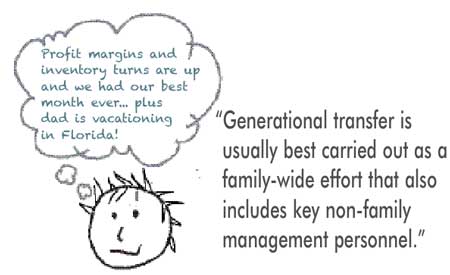Who in your organization will open a useful dialogue?
by David Lively
The furniture retailer seated in my office had spiked hair and rode into town in a pickup truck. He spoke excitedly about profit margins, inventory turns and his online strategy. Just listening to him speak, someone might assume that he was wearing pin stripes, seated in a leather wingback and wearing wingtip shoes. But it would have been a mistake for anyone to judge him by his appearance or his youth, because this man had singlehandedly led the family’s furniture store during the two biggest months in their 50-year history, and this while the owner, his father, was in Florida. This success story resulted form the young man’s talent and work ethic as well as his father’s willingness to hand over the reins and let his son lead. But this is not the norm for the furniture industry.

Two out of five family businesses will transfer control and assets to the next generation in the next ten years. This is according to James Olan Hutcheson of ReGENERATION Partners. The following sobering statistics for independent business owners will make this generational transfer difficult for some of their inheritors:
• Over the next 20 years nearly $4.8 trillion of wealth will be transferred to the next generation of heirs.
• One in five retailers lost money on average during the last two decades.
• One in four private companies had income of less than $10,000 pre-tax per year on average during the last two decades.
In the late 1990s, Arthur Anderson and the Illinois Retail Merchants Association conducted in an extensive study of over 1,500 of the association’s members. Many owners were quoted as saying, "Success is increasing profits, and we are not," or "I should be earning more based on the hours I give to this company." These are not uncommon sentiments in today’s retail furniture environment.
So whether you run a highly successful business, or you are working long hours for unsatisfying compensation, here’s what you need to know to start to successfully transition your business to the next generation.
When Preparedness
Meets Opportunity
Most family businesses are not prepared to handle the tidal wave of wealth transfer. In fact, the majority of family businesses have made few or no provisions for turning them over to the next generation. One problem is that most healthy and active family leaders find it difficult to envision their own retirement or, worse, death. Another is that the challenges of family-business succession tend to be barbed and bristly. It's easy for business leaders to accept their seniority when purchasing a life insurance policy. It's more difficult to engage in the sort of personal soul searching, family dialogue, and complex financial planning required to prepare for succession.
Generational
Transfer Defined
In the context of this article, the term generational transfer is used to describe an organization-wide change such as:
• A change in mission.
• Restructuring operations.
• New technologies.
• Mergers.
• Major collaborations.
• "Rightsizing".
• New programs such as 6-Sigma.
• The change of leadership at the top because of generational transfer.
It designates a fundamental and radical reorientation in the way the organization operates. It does not include smaller changes such as adding a new person, modifying a program or adding a product category.
What Provokes Generational Transfer?
Usually generational transfer is provoked by some major outside driving force such as:
• A substantial downturn in sales
volume.
• The need to address major new
markets.
• The need to increase productivity.
• The aging of today’s small business owner.
Typically, generations must undertake organization-wide change to evolve to a different level in their life cycle, such as going from an entrepreneurial organization to more stable and planned development.
Why Is It Difficult to Accomplish?
Generational transfer is often difficult to accomplish because there is strong resistance to change in most organizations.
• Current owners are forced to face their mortality.
• People are afraid of the unknown.
• Many people think things are currently fine and don't understand the need for change.
• Many are inherently cynical about change.
• Most doubt there are effective means to accomplish major generational transfer.
• Often there are conflicting goals between the generations, such as retirement verses growth, or asset protection verses new business development.
• Often there are questions as to which resources are needed to accomplish the transfer.
Advisors of every type appear like wolves in the night looking for an easy meal, and the resulting agreements can often go against values held by family members. That’s why generational transfer plans must address needed changes in the culture of organizations, as well as to family members' values and beliefs. This is a process that may require painful, but much required hand-holding to be successful.
The challenges that large publicly traded companies encounter when planning for change is very different than those faced by closely held organizations. In the later, the keys for successful transition usually hinge on effectively managing family relationships.

"I firmly believe kids don’t want your understanding. They want your trust, your compassion, your blinding love and your car keys, but try to understand them and you’re in big trouble." –Erma Bombeck
How is Generational Transfer Best Carried Out?
Successful change must involve top management, including the board of directors and chief executive. Usually there's a visionary, a persuasive and consistent champion who initially instigates the change.
The transfer of stock, or other company assets should be considered the least of the challenges to be addressed in most cases. The most pressing concern for organizations undergoing this process is to responsibly translate a vision of how things might be, into a realistic plan that can subsequently be carried out. Generational transfer is usually best implemented as a family-wide effort that also includes key non-family management personnel.
Communication about the transfer should be frequent and include all family and organization members. To sustain change, the organizational structure will likely be modified, including strategic plans, policies and procedures. This structural change typically involves testing, cooling down, and finally implementation of the revised process. The best approach to address resistance is through communication and education. The owner/parent should meet with all managers and staff to explain reasons for change, how it will be carried out and how to find pertinent information. This will help to avoid misunderstandings and needless anxiety among stakeholders in the organization. The plan should be developed and communicated, but if changes are made, the details and reasons need to be explained as well. Be sure to hold scheduled meetings so that family and other company members can express their ideas, concerns, and frustrations.
Some General Guidelines
to Generational Transfer:
1.Broadly communicate the reasons for change. Openly discuss what you’re doing and how it will succeed.
2.Get feedback from managers, leaders, and employees. Ask what they think are the problems and how to resolve them. If possible, work with a team of employees to manage the change.
3.Don't get wrapped up in "doing" change. Know when and why you're making a change. Be sure of the goal(s) you hope to accomplish.
4.Plan the change. How do you plan to reach the goals? What will you need to reach the goals?
5.How long might it take and how will you know when you've reached your goals or not? Make certain someone is in charge of the plan.
6.Job descriptions are essential in specifying who reports to whom during the time of transition. Try to have each employee report to one identifiable person.
7.Delegate decisions to the next generation of leaders as much as possible. Grant them the authority and responsibility to get the job done. As much as possible, let them decide how to do the project.
8.The process will take longer than you think.
9.Keep your perspective. Stay focused on meeting the needs of your customers.
10.Take care of yourself. Generational transfer can be highly stressful.
11.Don't seek to control change. Plan plans, not the results.
12.Plan an ending. Celebrate accomplishments.
"This free will business is a bit terrifying anyway. It’s almost pleasanter to obey, and make the best of it." –Ugo Betti
To Everything There is a Season,
a Time for Every Purpose.
Success in generational transfer is paradoxical. Deep chemical change happens when we move from negative destructive behavior to positive constructive behavior, from wrong doing to making things right, from looking back to looking forward, from placing blame to taking responsibility, from denial to repentance, and remorse to forgiveness. We grow in our humanity when we transition from not having a voice to saying what we mean, from being silent to engaging in conversation, from anticipating betrayal to cultivating trust, from alienation to connection and collaboration, from being incomplete to experiencing closure, from lack of empathy to understanding, from lying to truth telling, from no self-worth and meaninglessness to self-worth and meaning.
An open and understanding dialogue must occur between the generational divide for effective and lasting change to occur. Regardless of who makes the first move on the chess board of life by writing a letter, sending an email or inviting the other to lunch, the very process of reaching out almost always results in the beginnings of positive generational transfer.
David Lively, partner at The Lively Merchant, has over 20 years hands-on experience in the home furnishings industry, from the warehouse to the sales floor to the boardroom. He has walked the walk and talked the talk from the family-owned, single-site store to the multi-state, multi-million dollar operation; from sales training to computer programming; from warehouse construction and operations to financial management; from new store construction to complete renovation. Twice named to the "Beyond the Top 100" list of independent retailers and 1997 "Ohio Retailer of the Year," David's wisdom was won on the front lines of a furniture store and his battle scars have given him compassion for counseling today's retail warrior. David’s experience has led him to address the issues of the transfer of authority, responsibility and wealth from one furniture store generation to the next. The surviving legacy of your family business depends on your plan for transition, and David has developed a system for helping to identify goals, strengths and opportunities during this crucial time.
Read more of David Lively’s articles
for family furniture businesses on the furninfo.com website. You can reach David by calling 740.415.3192 or email him at davidL@furninfo.com. David has offered free phone consultations to any FURNITURE WORLD readers who would like to talk about topics related to family business transition.